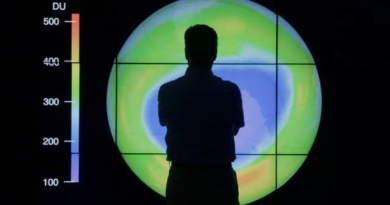Why You Shouldn’t Worry About Being Drawn into the Supermassive Black Hole at the Milky Way’s Core

Black holes are infamous for devouring anything in their path, but the one at the heart of our galaxy poses no immediate threat— at least not for the next four billion years. In May 2022, astronomers achieved a groundbreaking feat by capturing the first-ever image of a colossal supermassive black hole, four million times more massive than the Sun, residing in the center of the Milky Way.
The Event Horizon Telescope, a global collaboration uniting observatories worldwide to create a high-resolution image, specializes in capturing the “shadows” cast by supermassive black holes. Rather than blocking light, a black hole forms a shadow by violently bending the surrounding space, distorting and redirecting light, including the glow from the matter swirling in its accretion disk.
This distortion creates a cloak of light around the black hole, leaving a central gap—the dark shadow that appears as a black hole to observers. The shadow is not dark because it blocks light; instead, it indicates the consumption of light by the black hole.
The event horizon, from which the telescope derives its name, is the spherical boundary around the black hole marking the point of no return. Anything crossing this boundary is inexorably drawn toward the center of the black hole. At the event horizon, the escape velocity equals the speed of light, setting a boundary beyond which nothing can escape due to Einstein’s theory of relativity.
The image of our supermassive black hole, Sagittarius A* (pronounced “Sagittarius-A-star”), not only confirms the existence of such black holes but also underscores the inescapable nature of relativity’s rules.
Sagittarius A* not only consumes passing light beams but also attracts gases, dust, and superheated plasma. Occasionally, it even devours entire stars, emitting bursts of x-ray light when torn apart by strong tidal forces. Though so far, we have witnessed Sagittarius A* consuming only clouds of gas, its potential appetite is vast.
Despite their portrayal in popular culture, black holes, regardless of size, pose no threat to those who wisely avoid getting too close. The key lies in understanding how gravity operates at varying distances. According to Einstein’s general relativity, gravitational pull results from the curvature of space around a massive object, affecting how objects and light move through that space.
While extreme tidal forces near a black hole’s singularity can destroy anything too close, beyond the event horizon, spatial curvature resembles that experienced at a similar distance from an ordinary star or massive object. Even if our Sun were to become a black hole now, Earth would continue its orbit unaffected, experiencing only darkness and coldness.
The supermassive black hole at the center of our galaxy holds no immediate threat to our Solar System’s stability. Its gravitational influence is overshadowed by the combined mass of stars, gas, and dust at the center, not to mention the pervasive dark matter. Our galactic orbit is secure for the time being.
However, in approximately four billion years, the Milky Way will collide with the Andromeda Galaxy, triggering cosmic chaos. This collision may lead to the merging of the supermassive black holes at the galaxies’ centers. While the future of our local group of stars remains uncertain, one can hope that somewhere in the cosmos, a captivating view will be captured by a keen-eyed observer.








